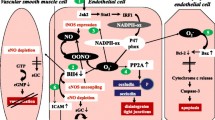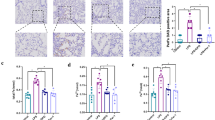Summary
The role of polymorphonuclear neutrophils (PMN) in the injury of the heart following ischemia and reperfusion is still controversial. The aim of this study was to investigate whether small numbers of PMN may cause myocardial dysfunction in an isolated system, how the resulting loss of function can be characterized and whether the formation of hypochlorous acid (HOCl) can be responsible for the PMN-mediated effect.
Isolated working guinea pig hearts were subjected to a 90% reduction of coronary flow for 30 min, with or without intracoronary infusion of homologous PMN (approximately 1–2×105 cells/min, i.e. about 5–10% of normal blood count). This ischemia was followed by a 15 min reflow period in a non-working (“Langendorff”) mode before work was resumed.
In hearts perfused only with buffer, post-hypoxic heart function recovered to 75–80% of the initial value. Inclusion of unstimulated PMN did not further attenuate cardiac function. However, cardiac output was decreased to 42% of the initial value, provided thrombin (0.3 U/ml) and H2O2 (10−5 M) were also present, and the retained PMN (about 10% of those infused) were additionally stimulated during reflow by application of FMLP (10−6 M for 1 min). In these instances, coronary flow at any time of the experiment and release of lactate or purines during ischemia and reflow did not differ significantly between hearts perfused with or without PMN. There was no substantial release of myoglobin in controls and in PMN-treated hearts. Inotropic stimulation of the hearts with noradrenaline or exogenous Ca2+ caused a sustained increase in contractile force. However, the response was significantly reduced in PMN-perfused hearts in comparison to control hearts. The myocardial contents of high-energy phosphates with and without inotropic stimulation proved to be identical irrespective of whether experiments had been performed in the absence or presence of PMN.
A similar loss of myocardial function as mediated by PMN could be produced by infusing chemically generated hypochlorous acid (HOCl, 5×10−7 M for 10 min). Strikingly, that portion of the infused HOCl which actually reacted with cardiac tissue was comparable to the amount shown to be generated by stimulating 106 PMN retained in the coronary system (about 7 nmoles). Supplementing the perfusate with the scavengers L-methionine (10−4 M) or uric acid (5×10−4 M) prevented the attenuation of heart function provoked by PMN.
The results indicate that small numbers of PMN, sufficiently activated, can depress cardiac function after 30 min of ischemia. No evidence for capillary plugging was obtained, rather, similarities to the phenomenon of myocardial stunning were evident. Moreover, the generation of HOCl appears to be a likely cause for this PMN-mediated effect.
Similar content being viewed by others
References
Alloatti G, Montrucchio G, Emanuelli G, Camussi G (1992) Platelet-activating factor (PAF) induces platelet/neutrophil co-operation during myocardial reperfusion. J Mol Cell Cardiol 24:163–171
Bagchi D, Das DK, Engelman RM, Prasad MR, Subramanian R (1990) Polymorphonuclear leucocytes as potential source of free radicals in the ischemic-reperfused myocardium. Eur Heart J 11:800–813
Becker BF, Gerlach E (1987) Uric acid, the major catabolite of cardiac adenine nucleotides and adenosine, originates in the coronary endothelium. In: Gerlach E, Becker BF (eds) Topics and Perspectives in Adenosine Research. Springer, Berlin Heidelberg, pp 209–222
Becker BF, Reinholz N, Özçelik T, Leipert B, Gerlach E (1989) Uric acid as radical scavenger and antioxidant in the heart. Pflügers Arch 415:127–135
Bednar M, Smith B, Pinto A, Mullane KM (1985) Nafazatrom-induced salvage of ischemic myocardium in anesthetized dogs is mediated through inhibition of neutrophil function. Circ Res 57:131–141
Bolli R (1990) Mechanism of myocardial “stunning”. Circulation 82:723–738
Bradley PP, Priebat DA, Christensen RD, Rothstein G (1982) Measurement of cutaneous inflammation: estimation of neutrophil content with an enzyme marker. J Invest Dermatol 78:206–209
Bünger R, Sommer O, Walter G, Stiegler H, Gerlach E (1979) Functional and metabolic features of an isolated perfused guinea pig heart performing pressure-volume work. Pflügers Arch 380:259–266
Butcher EC (1991) Leukocyte-endothelial cell recognition: three (or more) steps to specificity and diversity. Cell 67:1033–1036
Carp H (1982) Mitochondrial N-formylmethionyl proteins as chemoattractants for neutrophils. J Exp Med 155:264–275
Chatelain P, Latour JG, Tran D, de Lorgeril M, Dupras G, Bourassa M (1987) Neutrophil accumulation in experimental myocardial infarcts: relation with extent of injury and effect of reperfesion. Circulation 75:1083–1090
De Lorgeril M, Basmadjian A, Lavallée M, Clément R, Millette D, Rousseau G, Latour JG (1989) Influence of leukopenia on collateral flow, reperfusion flow, reflow ventricular fibrillation, and infarct size in dogs. Am Heart J 117:523–532
De Servi S, Mazzone A, Ricevuti G, Fioravanti A, Bramucci E, Angoli L, Stefano G, Specchia G (1990) Granulocyte activation after coronary angioplasty in humans. Circulation 82: 140–146
Engler RL, Dahlgren MD, Peterson MA, Dobbs A, Schmid-Schönbein GW (1986) Accumulation of polymorphonuclear leukocytes during 3-h experimental myocardial ischemia. Am J Physiol 251:H93-H100
Engler R, Covell JW (1987) Granulocytes cause reperfusion ventricular dysfunction after 15-minute ischemia in the dog. Circ Research 61:20–28
Esser E, Loschen G (1991) Leukocytic O2 − and cardiac dysfunctions in isolated perfused rat hearts. Arch Toxicol 65:361–365
Fantone JC, Ward PA (1982) Role of oxygen-derived free radicals and metabolites in leukocyte-dependent inflammatory reactions. Am J Pathol 107:397–418
Geng JG, Bevilacqua MP, Moore KL, McIntyre TM, Prescott SM, Kim JM, Bliss GA, zimmerman GA, McEver RP (1990) Rapid neutrophil adhesion to activated endothelium mediated by GMP 140. Nature 343:757–760
Gerlach E, Becker BF (1990) The vascular endothelium: interactions with hemostatic mechanisms (platelets, coagulation, fibrinolysis). In: Bleifeld W et al (eds) Unstable Angina. Springer. Berlin Heidelberg, pp 3–15
Gillespie MN, Kojima S, Kunitomo M, Jay M (1986) Coronary and myocardial effects of activated neutrophils in perfused rabbit hearts. J Pharmacol Exp Ther 239:836–840
Gillespie MN, Kojima S, Owasoyo JO, Tai HH, Jay M (1987) Hypoxia provokes leukotriene-dependent neutrophil sequestration in perfused rabbit hearts. J Pharmacol Exp Ther 241:812–816
Gillespie MN, Booth DC, Friedman BJ, Cunningham MR, Jay M, DeMaria AN (1988) FMLP provokes coronary vasoconstriction and myocardial ischemia in rabbits. Am J Physiol 254:H481-H486
Go LO, Murry CE, Richard VJ, Weischedel GR, Jennings RB, Reimer KA (1988) Myocardial neutrophil accumulation during reperfusion after reversible or irreversible ischemic injury. Am J Physiol 255:H1188-H1198
Gutmann I, Wahlefeld AW (1974), L-(+)-Laktat-Bestimmung mit Laktat-Dehydrogenase und NAD+. In: Bergmeyer MU (ed) Methoden der enzymatischen Analyse. Verlag Chemie, Weinheim, pp 1510–1514
Heusch G, Frehen D, Kröger K, Schulz R, Thämer V (1988) Integrity of sympathetic neurotransmission in stunned myocardium. J Appl Cardiol 3:259–272
Hearse DJ, Bolli R (1992) Reperfusion induced injury: manifestations, mechanisms, and clinical relevance. Cardiovasc Res 26:101–108
Hoshida S, Kuzuya T, Fuji H, Oe H, Hori M, Kamada T, Tada M (1993) Transcardiac alteration of neutrophil function relates to myocardial ischaemia/reperfusion injury. Cardiovasc Res 27:377–383
Ito BR, Tate H, Kobayashi M, Schaper W (1987) Reversibly injured, postischemic canine myocardium retains normal contractile reserve. Circ Res 61:834–846
Kishimoto TK, Jutila MA, Berg EL, Butcher EC (1989) Neutrophil Mac-1 and MEL-14 adhesion proteins inversely regulated by chemotactic factors. Science 245:1238–1241
Kraemer R, Mullane KM (1989) Neutrophils delay functional recovery of the post-hypoxic heart of the rabbit. J Pharmacol Exp Ther 251:620–626
Leipert B, Becker BF, Gerlach E (1992) Different endothelial mechanisms involved in coronary responses to known vasodilators. Am J Physiol 262:H1676-H1683
Lucchesi BR, Werns SW, Fantone JC (1989) The role of the neutrophil and free radicals in ischemic myocardial injury. J Mol Cell Cardiol 21:1241–1251
Mullane KM, Read N, Salmon JA, Moncada S (1984) Role of leukocytes in acute myocardial infarction in anesthetized dogs: Relationship to myocardial salvage by anti-inflammatory drugs. J Pharmacol Exp Ther 228:510–522
Myers ML, Webb C, Moffat M, McIver D, Del Maestro R (1991) Activated neutrophils depress myocardial function in the perfused rabbit heart. Can J Cardiol 7:323–330
Myers ML, Webb C, Moffat M, McIver D, Del Maestro R (1992) Activated neutrophils impair rabbit heart recovery after hypothermic global ischemia. Ann Thorac Surg 53:247–252
Nathan CF (1987) Neutrophil activation on biological surfaces. Massive secretion of hydrogen peroxide in response to products of macrophages and lymphocytes. J Clin Invest 80:1550–1560
O'Neill PG, Charlat ML, Michael LH, Roberts R, Bolli R (1989) Influence of neutrophil depletion on myocardial function and flow after reversible ischemia. Am J Physiol 256:H341-H351
Patel KD, Zimmerman GA, Prescott SM, McEver RP, McIntyre TM (1991) Oxygen radicals induce human endothelial cells to express GMP-140 and bind neutrophils. J Cell Biol 112:749–759
Prosad K, Kalra J, Chaudhary AK, Debnath D (1990) Effect of polymorphonuclear leukocyte-derived oxygen free radicals and hypochlorous acid on cardiac function and some biochemical parameters. Am Heart J 119:538–550
Romson JL, Hook BG, Kunkel SL, Abrams GD, Schork MA, Lucchesi BR (1983) Reduction of the extent of ischemic myocardial injury by neutrophil depletion in the dog. Circulation 67:1016–1023
Schwartz LM, Raschke P, Becker BF, Gerlach E (1993) Adenosine contributes to neutrophil-mediated loss of myocardial function in postischemic guinea pig hearts. J Mol Cell Cardiol, in press
Semb AG, Ytrehus K, Vaage J, Myklebust R, Mjos OD (1989) Functional impairment in isolated rat hearts induced by activated leukocytes: protective effect of oxygen free radical scavengers. J Mol Cell Cardiol 21:877–887
Shappell SB, Toman C, Anderson DC, Taylor AA, Entman ML, Smith CW (1990) Mac-1 (CD11b/CD18) mediates adherence-dependent hydrogen peroxide production by human and canine neutrophils. J Immunol 144:2702–2711
Shuman MA, Levine SP (1978) Thrombin generation and secretion of platelet factor 4 during blood clotting. J Clin Invest 61:1102–1106
Simpson PJ, Fantone JC, Mickelson JK, Gallagher KP, Lucchesi BR (1988) Identification of a time window for therapy to reduce experimental canine myocardial injury: suppression of neutrophil activation during 72 hours of reperfusion. Circ Res 63:1070–1079
Test ST, Weiss SJ (1984) Quatitative and temporal characterization of the extracellular H2O2 pool generated by human neutrophils. J Biol Chem 259:399–405
Thomas EL, Grisham MB, Jefferson MM (1986) Preparation and characterization of chloramines. Methods Enzymol 132:569–585
Tsan M (1982) Myeloperoxidase-mediated oxidation of methionine. J Cell Physiol 111:49–54
Weiss SJ, Klein R, Slivka A, Wei M (1982) Chlorination of taurine by human neutrophils. Evidence for hypochlorous acid generation. J Clin Invest 70:598–607
Weiss SJ (1989) Tissue destruction by neutrophils. N Engl J Med 320:365–376
Williams FM, Collins PD, Tannière-Zeller M, Williams TJ (1990) The relationship between neutrophils and increased microvascular permeability in a model of myocardial ischemia and reperfusion in the rabbit. Br J Pharmacol 100:729–734
Winterbourn CC (1985) Comparative reactivities of various biological compounds with myeloperoxidase-hydrogen peroxide-chloride, and similarity of the oxidant to hypochlorite. Biochim Biophys Acta 840:204–210
Zimmerman GA, McIntyre TM, Prescott SM (1985) Thrombin stimulates the adherence of neutrophils to human endothelial cells in vitro. J Clin Invest 76:2235–2246
Zweier JL, Kuppusamy P, Shandelya SML, Thompson-Gorman S, Weisman HF, Fearon DT, Weisfeldt ML (1992) Electron paramagnetic resonance measurements of free radical generation in isolated cells and whole tissues. In: Jesaitis AJ, Dratz EA (eds) The Molecular Basis of Oxidative Damage by Leukocytes. CRC Press, Boca Raton, pp 181–201
Author information
Authors and Affiliations
Rights and permissions
About this article
Cite this article
Raschke, P., Becker, B.F., Leipert, B. et al. Postischemic dysfunction of the heart induced by small numbers of neutrophils via formation of hypochlorous acid. Basic Res Cardiol 88, 321–339 (1993). https://doi.org/10.1007/BF00800639
Received:
Accepted:
Issue Date:
DOI: https://doi.org/10.1007/BF00800639




